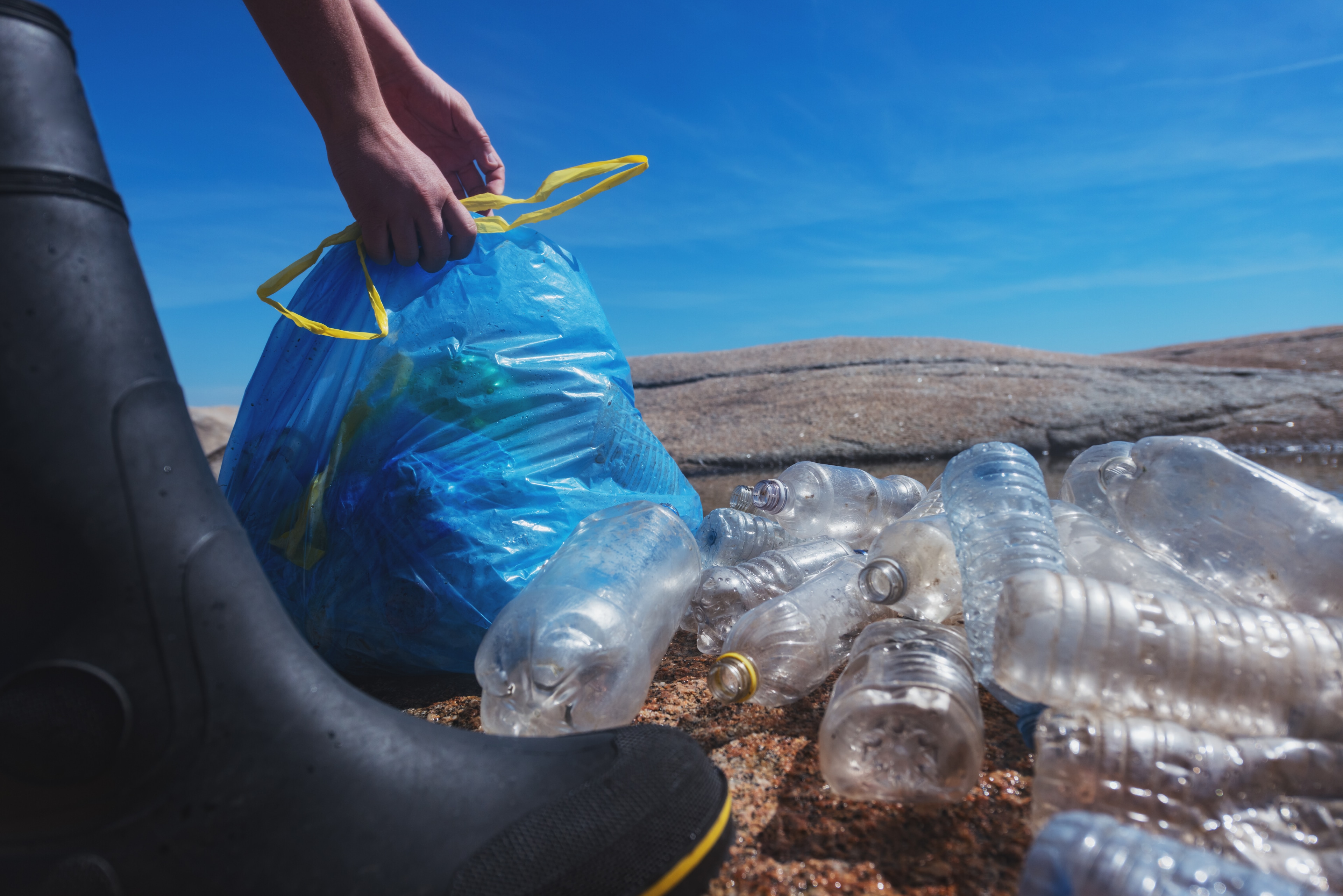Reuse systems: in search of a vision for tackling plastic pollution

Plastic pollution is.a global problem
Image: Photo by Nick Fewings on Unsplash
Stay up to date:
Future of the Environment
Listen to the article
- Governments and other stakeholders from business and civil society are coming together to tackle the huge problem of plastic pollution.
- 175 governments are about to kick off negotiations in Uruguay to create a legally binding global plastics treaty.
- Reuse systems could play a central role in shaping how we produce, distribute and consume products and reduce plastic pollution.
We're at a critical moment. The planet faces strains across its boundaries and 175 governments are about to kick off negotiations in Punta del Este, Uruguay, to land a legally binding global plastics treaty. The world is watching. What has united governments and other stakeholders from business and civil society is the alarming magnitude and accelerating growth of plastic pollution. The crisis is undeniable and overwhelming.
Uniting around the problem is a good start. But it is not enough. Only by uniting around a joint vision for the future can we unlock action and bring about change. What do we want our world to look like tomorrow? Once stakeholders recognize a destination, they can start taking steps towards achieving it. Citizens, communities, businesses and governments can then work to understand what they must do – individually and collectively – to advance towards the destination.
What's the World Economic Forum doing to tackle air pollution?
What is that vision?
The vision will be co-created across regions, communities, sectors and perspectives – hopefully, propelled by a tight two-year negotiation window for reaching a global agreement. Conversations are starting, and with the collective search for a vision underway, it is helpful to put hypotheses on the table.
In that spirit, one hypothesis for discussion is the following: in tomorrow’s world, reuse systems will play a central role in shaping how we produce, distribute and consume products – including fast-moving consumer goods, such as food and beverage, personal care and home care products. Such single-use items currently account for half of all plastic produced.
Speaking in Uruguay, Monica Medina, US Assistant Secretary of State for Oceans and International Environmental and Scientific Affairs, was keen to kick off a multistakeholder conversation on reuse systems.
We should think big and explore together how we can build innovative business models that drive growth and sustainability through reuse and waste prevention strategies upstream. We hope to work closely with efforts, such as the Global Plastic Action Partnership, that bring stakeholders together to drive systemic change.
”How do reuse systems work?
Reuse in this context means the multiple uses of packaging items, such as coffee cups, take-out food containers, shampoo bottles or soap dispensers. Reuse requires the use of durable packaging formats that can withstand multiple-use cycles.
Reuse systems are comprised of a coordinated web of transactions and they exist in many shapes and sizes. A restaurant using reusable tableware is a perfect example of a localised reuse system; music festivals or stadiums using returnable cups; water dispensers in schools; soap dispensers in supermarkets; large-scale bottle refill schemes involving brands and retailers in countries such as Germany or Brazil; global pools of shipping pallets and containers that can be reused thousands of times for moving cargo.
These systems have in common an approach that aims to ensure that production and consumption are largely decoupled from packaging waste. In a world where reuse systems can scale in multitude and magnitude, they have the potential to substantially reduce resource extraction, material use and waste management operations required for single-use packaging. Just last week, the WWF released its global position paper on reuse.
If done right, reuse has the incredible potential to be a high-impact solution to the plastic crisis, transforming the way we purchase and use materials, with benefits going beyond just protecting our environment to driving innovation and growth.
”Reuse systems interacting
When reuse systems interact and interoperate across product categories, supply chains and geographies, they create a ‘system of systems’ that can serve local, national or global markets and applications. This larger system then generates synergies and efficiencies of scale across multiple areas, including consumer convenience, collection, logistics, cleaning and refill operations.
Today, cities such as Seattle, London and Jakarta are building dedicated programmes for accelerating reuse solutions. Governments such as Chile and France are advancing legislation to mandate reuse alternatives. Corporations such as Nestlé, Coca-Cola and Aeon are piloting new product design, delivery and retail models.
And, innovative solution providers such as Siklus, Again, Muuse and Circolution are developing software that enables dispensing, washing, packaging and logistics services to bring reuse solutions to life. Most of these efforts and pilots have been isolated, proprietary and small-scale, but initiatives with a broader systems vision are gaining momentum, such as global reuse standards being advanced by PR3.
As we search for a shared vision for tomorrow, here are the top reasons why reuse systems merit being put on the table for discussion:
1. Reuse systems imply systems change
Reuse systems require businesses to redesign their products and operations. Consumers need to shift behaviours and governments need to rethink policy and infrastructure. Reuse systems do not pretend to fix a broken system, they aspire to build a new one. Their ambition is to shift from overinvesting in treating symptoms (recycling, incinerating or landfilling the growing volume of single-use packaging waste) to addressing the root cause of the crisis (reducing the volume of single-use packaging waste generated).
2. Reuse systems accommodate different solutions
Reuse systems are not a silver bullet. They provide a new normative and operational framework within which other innovations can flourish – including new business models, advanced products and material innovation. Reuse systems can accommodate varying materials depending on the product and its required functionality. They also interplay with recycling systems when reusable containers reach their end-of-life after multiple use cycles. Finally, reuse systems must not be a blanket substitute for all single-use applications where these may continue to make sense.
3. Reuse systems are adaptive
A local coffee shop will think about reuse systems differently from a multinational supermarket chain. Mexico City will have different needs from a small island state. A system of reuse systems allows for local ownership and adaptation and also for national or international norms, where these can help ensure interoperability, commercial viability, cross-border trade or public health and safety.
4. Reuse systems are participatory
Reuse systems touch local communities: school cafeterias, university campuses, boroughs, and cities. Even large-scale reuse systems imply consumer engagement. In this sense, reuse is a more accessible enabler for change than specialised scientific and technological innovation in materials or waste treatment processes, which give most citizens little, if any, agency. Reuse is a behaviour, an action that anyone understands and that many cultures have been embracing for generations. It can mobilise citizens, communities, electorates and consumers in support of a shared vision.
The integrative, adaptive and participatory characteristics of reuse systems make them highly scalable. Achieving true systems change, however, requires all stakeholders to move in the same direction in a committed, coordinated and collaborative way. It requires a clear transition plan, ambitious but realistic targets, substantial investments and serious accountability.
Accept our marketing cookies to access this content.
These cookies are currently disabled in your browser.
Only a shared vision can unlock such collective action
Will reuse systems appear in the vision and the outcome of the discussions toward a legally binding agreement on plastic pollution? Or will they remain a hypothesis and cede to other ideas and ambitions? The next two years will tell – and it is critical that this important topic remains at the forefront of the conversations. By focusing the world’s attention on the important issue of plastic pollution, the treaty process provides a unique and precious opportunity to rally the global community behind a collective vision with objectives and outcomes – let's continue to push for them to be ambitious and holistic.
Don't miss any update on this topic
Create a free account and access your personalized content collection with our latest publications and analyses.
License and Republishing
World Economic Forum articles may be republished in accordance with the Creative Commons Attribution-NonCommercial-NoDerivatives 4.0 International Public License, and in accordance with our Terms of Use.
The views expressed in this article are those of the author alone and not the World Economic Forum.
Forum Stories newsletter
Bringing you weekly curated insights and analysis on the global issues that matter.
More on Nature and BiodiversitySee all
María Daniela Limongi Izaguirre, Edwin Josue Castellanos and Marisol Argueta de Barillas
September 22, 2025
Michael Donatti and Benoit Bégot
September 19, 2025
Tom Crowfoot
September 18, 2025
Caroline Meech and Sakshee Singh
September 17, 2025
Tania Strauss and Beverley Postma
September 17, 2025
Metolo Foyet
September 16, 2025






